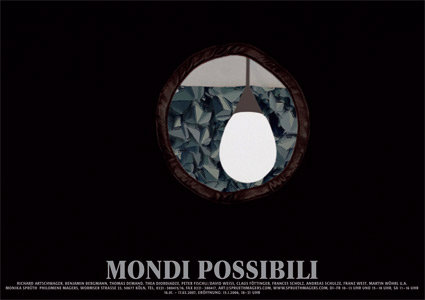Mondi possibili
dal 14/1/2007 al 16/3/2007
Segnalato da
Benjamin Bergmann
Thomas Demand
Thea Djordjadze
Peter Fischli
David Weiss
Thomas Grunfeld
Stefan Kern
Frances Scholz
Andreas Schulze
Franz West
Martin Wohrl
14/1/2007
Mondi possibili
Monika Spruth Philomene Magers, Koln
New edition

New edition
As part of the PASSAGEN, the supporting programme of the International Furniture Fair in Cologne, at the beginning of the year Monika Spruth and Philomene Magers present a new edition of the exhibition "Mondi Possibili".
On display will be works by artists such as Benjamin Bergmann, Thomas Demand, Thea Djordjadze, Peter Fischli/David Weiss, Thomas Grunfeld, Stefan Kern, Frances Scholz, Andreas Schulze, Franz West, and Martin Wohrl. This exhibition series is intended to be continued in the coming years. The first exhibition titled "Mondi Possibili", presenting furniture and objects created by artists, already dates back several years. Already in 1989 Monika Spruth presented in her space on Maria- Hilf-Strasse furniture-like objects by, among others, Tony Cragg, Peter Fischli/David Weiss, Katharina Fritsch, and Louise Lawler.
The works on display deal with the subject of furniture from a variety of angles: as citation, as homage, as adaptation, or as copy. Others are usable objects that hardly differ from their reference objects in the domain of design or furniture.
In an interview Richard Artschwager once referred to furniture as things which celebrate what people do. Artschwager's formal reductions of pieces of furniture may be understood as celebration. Celebrating their particular purpose at the formal and theoretical level, they are not suitable for actual use. This exhibition presents one of Artschwager's crate sculptures he started making in 1993 for a show at the Portikus in Frankfurt. The crates are constructed like the crates used to transport works of art and have various shapes, partly reminiscent of specific objects. The tablecloth-like wooden shape on its top side, the hinted-at silverware and plates of aluminium, as well as the title identify the crate on display as a table.
Usable objects have formed an important part of the work of Andreas Schulze from the beginning. His ceramic vases, fruit bowls or lamps, often integrated along with his paintings and other wall pieces in his installations, make formal references to middle-class home decor and kitsch. The blending of art and life, or of life and art's usability, finds genuine expression in the work of Andreas Schulze. Thus the curtain on display emerged from a real-life situation in the artist's former apartment. In order to separate the bay he had arranged as a guest room from the rest of the apartment, Andreas Schulze had the curtain made complete with a doorway, window, and a round opening for the ceiling lamp.
The ivy wallpaper covering part of the walls of the exhibition space was designed by Thomas Demand as a decorative element for his show at London's Serpentine Gallery in 2006. Each of the four rooms was lined with different coloured ivy wallpaper on which his paintings were installed. Outwardly, the exhibition space was thus turned from a white cube into a living space, evoking the Serpentine Gallery's original function as a tea pavilion. The wallpaper was printed by an English printer who to this day uses designs by William Morris for wallpapers.
The works of Thea Djordjadze make formal references and pay homage to works of Le Corbusier. In her latest work the artist deals with negative casts of shapes.
Martin Wohrl's sculptures and objects often quote or reference other works of art, but the artist also uses films as a source of inspiration. At the same time his works, like the floor piece on display, are mostly usable.
Galerie Spruth Magers
Wormser Strasse 23 - Koln
Office Hours: Tuesday - Friday, 9am - 6pm. Viewing Hours: Tuesday - Friday, 10am - 1pm and 3pm - 6pm. Saturday 11am - 4pm and by appointment



